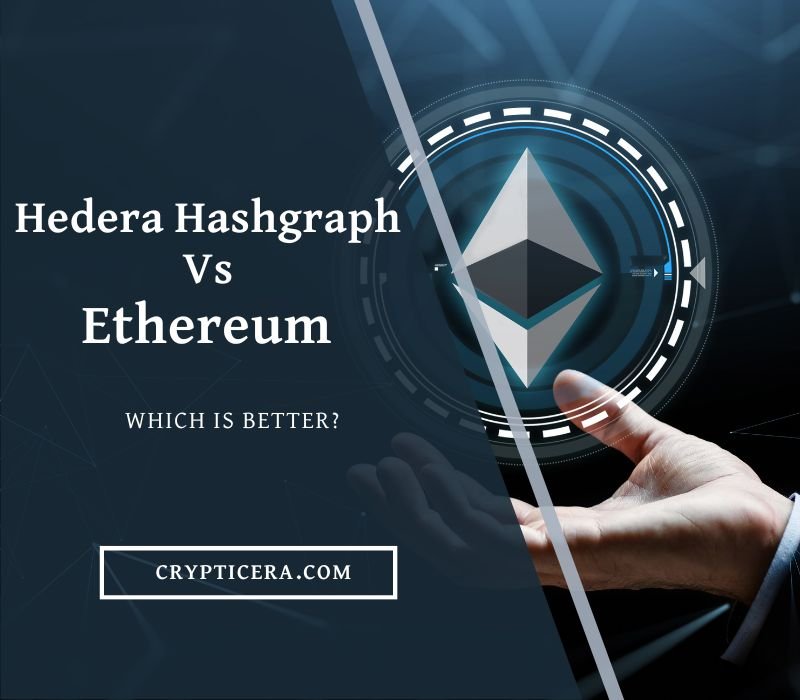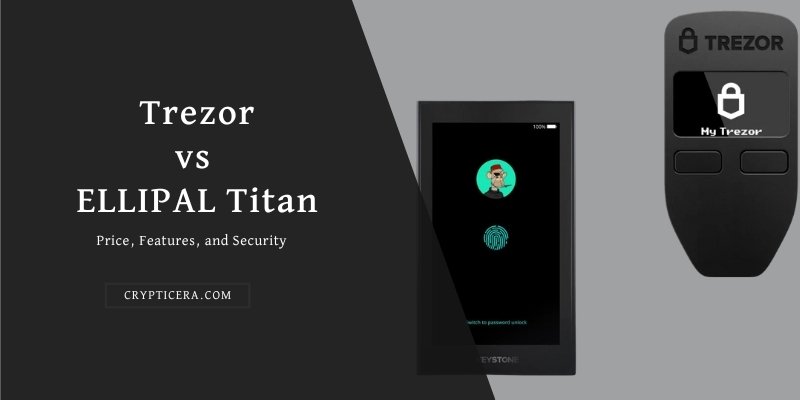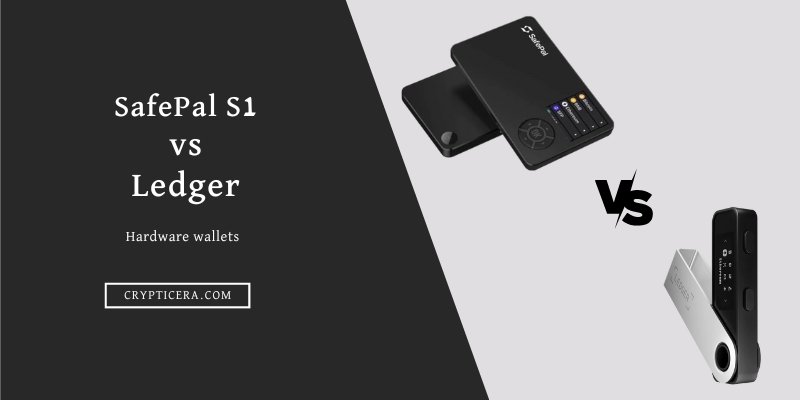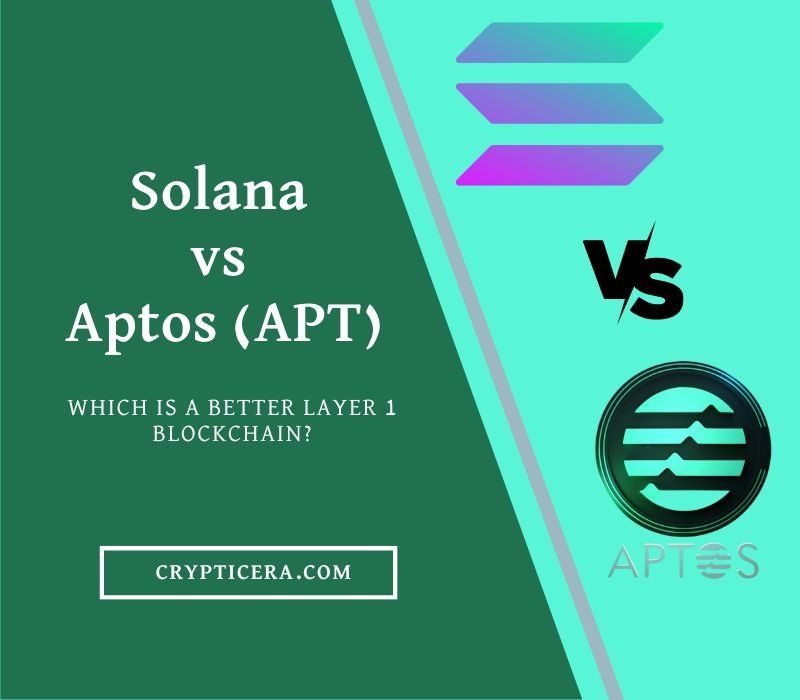Are you a blockchain enthusiast looking for the perfect platform to build your decentralized application on?
Look no further than “Hedera vs Ethereum”, two of the most popular and powerful blockchain networks on the market. But how do these two networks compare?
In this blog post, we’ll take an in-depth look at Hedera and Ethereum, examining their strengths, weaknesses, and key differences.
From security to scalability, we’ll explore everything you need to know to make an informed decision about which platform is right for your project.
So sit back, grab a cup of coffee, and get ready for the ultimate comparison of the Hedera and Ethereum blockchains.
Hedera vs Ethereum: Key Differences
Here is the comparison table between “Hedera vs Ethereum” based on the key specifications of blockchain technology like Scalability, consensus mechanism, Transaction throughput, and block time.
| Feature | Hedera Hashgraph | Ethereum |
|---|---|---|
| Consensus algorithm | asynchronous Byzantine Fault Tolerance (aBFT) | Proof of Stake (PoS) |
| Maximum Transactions per Second | Up to 10,000 | Up to 15 |
| Smart Contract support | Yes | Yes |
| Token standard | Hedera Token Service (HTS) | ERC-20 |
| Governance model | Centralized | Decentralized |
| Platform Type | Public Network | Public Network |
| Confirmations time | 3-5 seconds | 15 seconds – 2 minutes |
| Transaction Fees | Low | Low-High (depending on network congestion) |
| Security | High | High |
| Scalability | High | Moderate |
| Governance Tokens | HBAR | ETH |
| Market Cap | $1.8 billion | $197 billion |
What is Hedera Hashgraph (HBAR)?
Hedera Hashgraph is a distributed ledger technology (DLT) platform that uses a unique consensus mechanism known as the Hashgraph algorithm. It is based on “Asynchronous Byzantine Fault Tolerance (aBFT)”
It aims to provide a fast, fair and secure way to transfer value and information. HBAR is the native cryptocurrency of the Hedera Hashgraph network. It is used to pay for transactions and access smart contract execution on the network.
Hedera Hashgraph is designed to offer a number of benefits over traditional blockchain technology, including faster transaction speeds, lower fees, and improved security.
How does Hedera Hashgraph Work?
The Hashgraph algorithm is based on a directed acyclic graph (DAG) data structure, which allows for the parallel processing of transactions, resulting in faster confirmation times and improved scalability.
The algorithm also uses a virtual voting process, known as “gossip about gossip,” to achieve consensus on the state of the ledger.
Each node in the network maintains a copy of the ledger and participates in the consensus process. Transactions are grouped into “events” and broadcast to the network.
Each node then “gossips” about the events it has received to its peers, allowing the network to come to a consensus on the order of the events.
Asynchronous Byzantine Fault Tolerance (aBFT) allows for the network to reach a consensus even in the presence of malicious actors.
What is Ethereum (ETH) Blockchain?
Ethereum is a blockchain-based platform that allows developers to build decentralized apps (dApps) and smart contracts.
It’s similar to the blockchain technology that powers Bitcoin, but it’s more versatile and can handle a wider range of applications.
The Ethereum network is maintained by a network of nodes, and all the transactions are recorded on a public ledger called the Ethereum blockchain.
One of the key features of Ethereum is its support for smart contracts. These are self-executing contracts with the terms of the agreement between buyer and seller being directly written into lines of code.
These smart contracts can be used for a variety of purposes, from financial transactions to supply chain management.
Hedera HashGraph Vs Ethereum Blockchain: The Begineer’s Guide
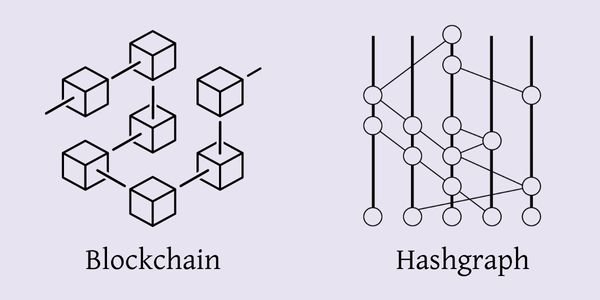
Transaction Speed
Hedera Hashgraph is known for its high transaction speed, with a potential of up to 10,000 transactions per second, and a block time of 3-5 seconds.
Ethereum, on the other hand, has a lower maximum transaction speed of up to 15-25 transactions per second, and a block time of 15 seconds to 2 minutes.
This makes Hedera Hashgraph a better option for applications that require fast and efficient transactions.
Consensus Mechanism
Hedera Hashgraph uses a consensus mechanism called Directed Acyclic Graph (DAG). It is a new form of distributed ledger technology that utilizes a new consensus algorithm known as the “asynchronous Byzantine Fault Tolerance“.
This approach allows for fast and efficient transactions while maintaining a high level of security.
On the other hand, Ethereum uses a consensus mechanism called Proof of Stake (PoS) which is a more traditional form of consensus mechanism.
PoS is a mechanism where nodes are selected to validate transactions based on the amount of cryptocurrency they hold.
DAG provides faster and more efficient transactions with less energy consumption, whereas PoS is more traditional but more secure and decentralized.
Smart Contract capability
On Hedera Hashgraph, smart contracts can be written in Solidity, LISP, Java, and Go. The platform supports a wide range of use cases including tokenization, gaming, and supply chain management.
The Hashgraph consensus algorithm ensures that smart contracts are executed quickly and securely.
Ethereum is considered the pioneer of smart contract platforms. Smart contracts on Ethereum can be written in Solidity and other programming languages.
The platform is widely used for the creation of decentralized applications (dApps) and the issuance of tokens through initial coin offerings (ICOs).
It has a large developer community and a wide range of tools and resources available to support the development of smart contracts.
DApps on Hedera Hashgraph
Here is the list of popular Decentralized Applications on the Hedera Hashgraph (HBAR) Platform-
- SaucerSwap DEX
- Heliswap
- HashGuild
- Hash Axis
- Stader (SD)
DApps on Ethereum Blockchain
Here is the list of popular Decentralized Applications on the Ethereum (ETH) blockchain-
- Uniswap DEX
- OpenSea NFT Marketplace
- Metamask Swap
- Sushiswap DEX
- 1INCH Network
- Polygon PoS Bridge
- LIDO Liquid Staking platform
- Ethereum Name Services
Asynchronous BFT vs PoS
aBFT, used by Hedera Hashgraph, is considered to be more secure in terms of preventing malicious actors from disrupting the network.
This is because aBFT utilizes a virtual voting mechanism, where each node votes for the next set of transactions, allowing for faster and more efficient transaction processing.
As a result, it is less susceptible to 51% attack and other forms of malicious behavior.
On the other hand, PoS, used by Ethereum, is a mechanism where nodes are selected to validate transactions based on the amount of cryptocurrency they hold.
This reduces the need for computational power, which in turn reduces energy consumption.
However, in a PoS system, the nodes that hold more cryptocurrency are more likely to be selected as validators, which could lead to centralization.
How to Build DApps on Hedera Hashgraph SDK?
As a developer using the Hedera Hashgraph SDK, here are the general steps to building an application on the Hedera network:
- Install the SDK: Start by installing the Hedera Hashgraph SDK in the programming language of your choice (Java, C#, JavaScript, Go, etc.).
- Create a Hedera account: Next, create a Hedera account by generating a new private key and corresponding public key.
- Connect to the Hedera network: Use the SDK to connect to the Hedera network and authenticate using the private key of your Hedera account.
- Perform operations: Once connected to the network, you can use the SDK to perform various operations such as creating new accounts, transferring cryptocurrency, storing data, and more.
- Build your application: Using the SDK’s API, you can now build your application on top of the Hedera network.
- Test and Deploy: Test your application locally, then deploy it to a live environment like in the cloud or on a local server.
How to Build DApps on Ethereum Blockchain?
Some general steps for building apps on Ethereum-
- Familiarize yourself with the basics of Ethereum and smart contracts.
- Choose a development environment and set up your development environment. You can use tools like Truffle or Embark to set up and manage your development environment.
- Learn Solidity, the programming language used to write smart contracts on Ethereum.
- Write and test smart contracts using your development environment.
- Deploy the smart contracts on a test network like Rinkeby or Ropsten to test their functionality.
- Once you are satisfied with the functionality of the smart contract, deploy it to the main Ethereum network.
- Use web3.js to interact with the smart contract and build a front end for your application.
- Test the application on the main Ethereum network and make any necessary changes.
- Finally, deploy the application to a hosting platform, such as IPFS, and make it available to users.
What is Distributed Ledger Database?
A distributed ledger database is a decentralized and distributed digital ledger that is used to record transactions across multiple computers.
It uses cryptography to secure and validate transactions. This allows for the creation of a tamper-proof record of data that is accessible to multiple parties.
Each block in the chain contains a record of multiple transactions, and once a block is added to the chain, its data cannot be altered.
This creates a transparent and secure method for recording and tracking transactions, making it well-suited for use in financial transactions, supply chain management, and other industries where data integrity is critical.
Additionally, the use of smart contracts allows for the automation of certain business processes and the creation of decentralized applications on top of the blockchain.
Comparison between Blockchain and Hashgraph
Both technologies use consensus algorithms to ensure the integrity of data on the network. However, Blockchain uses Proof of Work/Proof of Stake, while Hashgraph uses Gossip about Gossip or DAG.
Transactions per second on Hashgraph are significantly higher than on Blockchain, making it more scalable. Hashgraph is also considered to be more secure and has faster confirmation times.
However, Blockchain is considered to be more decentralized. In terms of data structure, Blockchain uses a linked list, while Hashgraph uses a directed acyclic graph.
| Feature | Blockchain | Hashgraph |
|---|---|---|
| Consensus Algorithm | Proof of Work/Proof of Stake | Gossip about Gossip |
| Transactions per Second | 7-15 | Up to 100,000 |
| Scalability | Limited | High |
| Security | High | Very High |
| Decentralization | Highly | Less |
| Data Structure | Linked List | Directed Acyclic Graph |
| Confirmation Time | 10-60 minutes | Seconds |
| Cost | High | Low |
| Energy Consumption | High | Low |
| Smart Contracts | Yes | Yes |
| Privacy | Limited | High |
Conclusion
In conclusion, Hedera Hashgraph and Ethereum are both promising technologies in the blockchain space, but they have distinct differences in terms of their design, scalability, and use cases.
Hedera Hashgraph, with its unique consensus algorithm, aims to provide high-throughput, low-latency, and secure transactions for enterprise and government use cases.
On the other hand, Ethereum, with its smart contract functionality, is geared towards decentralized applications and decentralized finance.
Ultimately, the choice between Hedera Hashgraph and Ethereum will depend on the specific needs and requirements of the application or project.
Both have the potential to revolutionize various industries and it will be interesting to see how they evolve and compete in the future.
